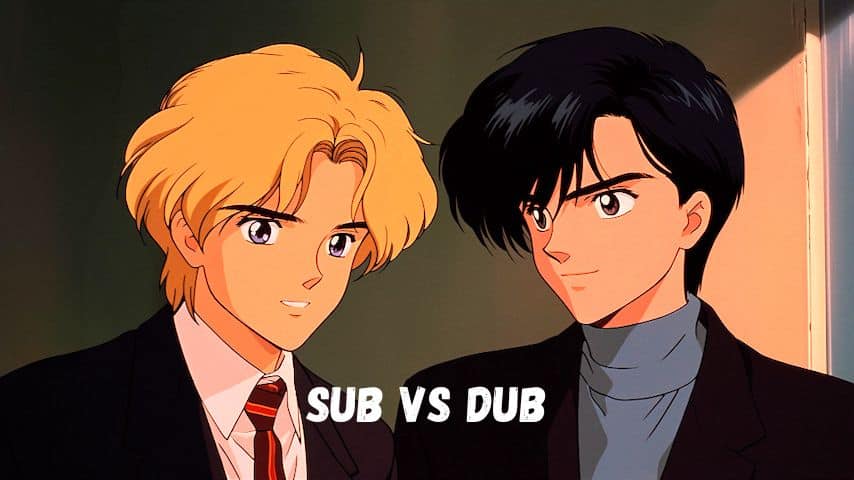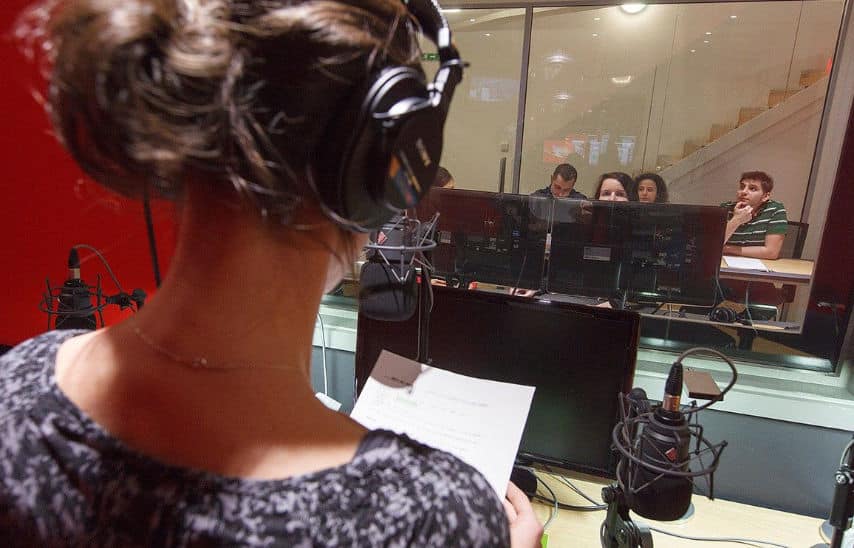When choosing between watching anime subbed or dubbed, understanding the difference between subbed vs dubbed is essential. In simple terms, subbed refers to watching anime with the original Japanese audio and translated subtitles, while dubbed means replacing the original audio with voice actors in another language, usually your own.
The choice between the two can change the way you experience anime, from the emotional connection to the characters to the cultural authenticity of the story.
In this article, we’ll explore these differences in detail and help you determine when each option might be most suitable for your viewing preferences.
What is Sub and Dub?
In the captivating universe of anime, the distinction between sub and dub is more than just a matter of language; it’s a choice that can significantly shape your viewing experience. Let’s delve into these two approaches and understand what sets them apart within the context of anime.
Subbed
Sub (short for subtitled) refers to watching anime with the original Japanese audio, accompanied by translated text displayed on the screen. This format allows viewers to hear the original voice acting while understanding the dialogue through subtitles in their language. Subtitling preserves the nuances and emotional depth of the characters’ performances, providing an authentic viewing experience.
Dubbed
Dub (short for dubbed) involves replacing the original Japanese voices with voice actors speaking in another language. In this format, the voice actors strive to match the tone, pacing, and emotions of the original performances while delivering the dialogue in the viewer’s language.
Dubbing offers a more accessible experience for those who prefer not to read subtitles, allowing them to focus on the visuals and action without distraction.
Table of Contents
ToggleWhat are the Differences Between Sub and Dub?
The key difference between subbed and dubbed animelies in how you experience the audio. Watching a sub allows you to hear the original Japanese voice acting, which often provides the most authentic representation of the characters. It also lets you experience the cultural nuances and language expressions in their original form. However, subs require you to read along with the dialogue, which might detract from your focus on the visuals.
On the other hand, dubbed anime replaces the original audio with voice actors speaking your language. This creates a more seamless viewing experience as you don’t have to read subtitles. However, some of the cultural references or original emotions might be lost in translation. Dubs are often easier for casual viewers or those unfamiliar with the Japanese language.
When to Use Subbed (Sub)?
Subbed are best used when:
- You want the authentic experience – If you’re interested in hearing the original voice actors and maintaining the integrity of the characters’ emotions and cultural nuances, subbed anime is the way to go.
- You’re learning Japanese – Watching anime with subtitles can help improve your language skills, as you’ll be exposed to both the spoken and written forms of Japanese.
- You prefer cultural immersion – Subtitles allow you to experience the story as close to its original form as possible, preserving jokes, idioms, and expressions that might be lost in translation.
- The dubbed version is of lower quality – In some cases, the dub might not be well done, either due to poor voice acting or a lack of emotion. Subtitles can help avoid that by sticking to the original performance.
Relevance in the Anime Industry
Subtitles play a pivotal role in the anime industry for several reasons:
- Global Audience: Anime enjoys a vast international fan base. Subtitles ensure that enthusiasts from diverse linguistic backgrounds can access and enjoy anime content.
- Artistic Integrity: Subtitles allow creators to preserve the integrity of their work. They can convey the intended messages, jokes, and cultural references to a wider audience while retaining the original voice acting.
- Language Learning: Subtitles contribute to language learning and cultural appreciation. They enable viewers to pick up Japanese phrases, words, and cultural nuances, fostering a deeper connection with the content.
Subtitles are the bridge that connects anime’s artistic brilliance with a global audience. They enhance accessibility, preserve originality, and offer a gateway to cultural immersion. As we journey through the world of Sub vs Dub, it becomes clear that subtitles play a vital role in enriching the anime-watching experience for viewers worldwide.
Read More: Dubbing vs Voice Over: What’s the difference?
What is the purpose of subtitles?
Subtitles are designed to make content accessible to a wider audience, particularly viewers who don’t understand the language being spoken. In anime, they allow non-Japanese-speaking audiences to enjoy the original audio while following along with translated text. Subtitles are often preferred by those who want to experience the anime as authentically as possible, preserving the original voice acting and cultural elements.
It’s also important to note that subtitles differ from closed captions. While subtitles focus on translating spoken dialogue, closed captions provide a transcription of all sounds, including background noises, which are useful for viewers with hearing impairments.
When to Use Dubbed (Dub)?
Dubbed is most suitable when:
- You prefer a more relaxed experience – Watching anime dubbed allows you to focus on the visuals and action without needing to constantly read the subtitles.
- You find subtitles distracting – If reading subtitles takes away from your enjoyment of the show, dubs can help by allowing you to simply listen and watch.
- You’re watching with a group – If you’re watching anime with friends or family who may not be used to subtitles, dubbed anime provides a more accessible experience for everyone.
- You want to multitask – Dubs are a great choice if you want to watch anime while doing other things, as you don’t have to split your attention between reading and watching.
What is the purpose of Dubbing?
Dubbing exists to make anime more accessible for international audiences who may not want to read subtitles. By replacing the original Japanese audio with voice actors speaking in the audience’s language, dubbed anime creates a smoother viewing experience, especially for those who prefer to listen rather than read.
Dubbing also allows for better engagement with the visuals and action of the anime, as viewers can focus entirely on what’s happening on-screen rather than splitting their attention between the visuals and subtitles.
10 Differences Between Sub and Dub
The Sub vs Dub debate within the anime community is as enduring as it is passionate. To gain a deeper understanding of this discourse, it’s essential to explore the key differences between subtitles (Sub) and dubbing (Dub). Let’s unravel these distinctions that shape how viewers experience anime.
1. Audio Authenticity:
- Sub: Retains the original Japanese audio, allowing viewers to hear the voices and emotions of the original cast.
- Dub: Replaces the original audio with voiceovers in the viewer’s language, offering a different auditory experience.
2. Reading vs. Listening:
- Sub: Requires viewers to read translated subtitles while listening to the original dialogue.
- Dub: Eliminates the need to read subtitles, allowing viewers to focus solely on listening and watching.
3. Language Mastery:
- Sub: Offers an opportunity to learn and appreciate the Japanese language and culture.
- Dub: Provides content in the viewer’s language, which may not facilitate language learning.
4. Cultural Nuances:
- Sub: Preserves cultural and linguistic nuances present in the original Japanese script.
- Dub: Adapts cultural references for the target audience, potentially altering the intended context.
5. Visual Focus:
- Sub: Requires viewers to divide their attention between reading subtitles and observing the animation.
- Dub: Allows viewers to fully engage with the visual elements of the anime.
6. Lip Sync:
- Sub: Requires no adjustments to match lip movements, as the original audio remains.
- Dub: Demands precise synchronisation of voiceovers with character lip movements.
7. Availability:
- Sub: Typically available sooner, as it involves only translation and subtitling.
- Dub: May take longer to produce due to voice acting and dubbing processes.
8. Accessibility:
- Sub: Can be challenging for individuals with visual impairments or reading disabilities.
- Dub: Offers a more accessible experience for such viewers.
9. Emotional Connection:
- Sub: Allows viewers to connect with the original voice actors’ performances.
- Dub: Builds an emotional connection through voice actors who reinterpret and portray characters.
10. Viewer Preference:
- Sub: Preferred by purists who value authenticity and language immersion.
- Dub: Chosen by those who seek convenience, a seamless experience, or prefer watching in their native language.
These ten distinctions highlight the multifaceted nature of the “Sub vs. Dub” debate, illustrating that the choice between subtitles and dubbing in anime is not merely a matter of language but a complex decision that impacts how viewers engage with and enjoy their beloved anime series.
What does dub mean in anime and why is it important?
In anime, dubrefers to the process of replacing the original Japanese voice acting with a newly recorded version in another language. This is important because it makes anime more accessible to viewers who may not want to or are unable to read subtitles. Dubs allow for a more immersive experience in terms of listening, making anime approachable for wider audiences, including younger viewers or those who may struggle with subtitles.
What are the costs associated with subtitling and dubbing anime?
Subtitling and dubbing come with different costs. Subtitling generally involves translating the dialogue and timing it with the original audio, making it a more cost-effective option compared to dubbing.
Dubbing, on the other hand, requires hiring voice actors, recording new dialogue, and syncing it with the characters’ lip movements. This makes it a more expensive and time-consuming process, but it offers a smoother viewing experience for audiences who prefer to listen to the dialogue in their own language.
Can sub or dub influence the cultural understanding of an anime series?
Yes, both subbedanddubbed versions can impact how cultural elements are conveyed. Subbed anime tends to preserve the original language’s cultural nuances, allowing viewers to experience the story as the creators intended. However, some viewers might find it challenging to fully understand the cultural context without some localisation.
In contrast, dubbed anime often adapts certain cultural references to make them more relatable to the target audience. While this makes the content more accessible, it can sometimes alter the original meaning or intent behind certain scenes, particularly with jokes or idioms that don’t translate directly.
Sub or dub: when should I use them?
Ultimately, choosing between subbed or dubbed anime comes down to your personal preferences and the situation.
Use subtitles if you value authenticity, want to hear the original voices, or are looking for a more immersive cultural experience. Subtitles are also helpful if you’re learning Japanese or enjoy hearing the original language.
Opt for dubs if you prefer a more seamless and relaxed experience, especially when you want to focus on the visuals or are watching with others who may not enjoy reading subtitles. Dubbing is also more convenient when you’re multitasking or want to enjoy the show without needing to pay close attention to the dialogue.
In the end, both subs and dubs have their place, and your choice should be based on how you prefer to experience anime.
Final Thoughts
In the ever-changing world of anime, the Sub vs Dub debate reflects the different tastes of viewers. As we explored the differences between subtitling and dubbing, we found that this choice goes beyond language. It involves things like culture, immersion, and accessibility. The main point is that there’s no one-size-fits-all answer to which is better; it comes down to personal preference.
When you’re enjoying the diverse world of anime, having reliable partners for subtitling and dubbing is essential. GoLocalise offers top-quality subtitling and dubbing services, committed to delivering quality while preserving the cultural aspects of the anime. With GoLocalise, your anime experience will always be captivating and engaging.
Ready to elevate your anime experience?
Reach out to GoLocalise today for all your subtitling and dubbing requirements. Whether you’re a content creator looking to expand your audience or a fan seeking a more immersive viewing experience, GoLocalise has you covered.
Visit GoLocalise’s website or contact them to explore how they can bring your anime projects to life. Don’t miss the opportunity to unlock the full potential of your anime journey with GoLocalise by your side.






















